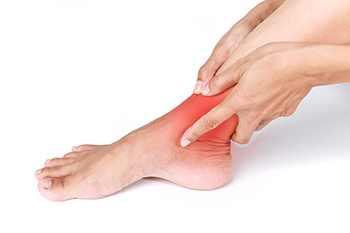
Ankle pain, often caused by injury, instability, or arthritis, can significantly increase the risk of developing osteoarthritis in the knee. When the ankle joint is compromised, it disrupts the natural biomechanics of walking leading to altered gait patterns. This imbalance shifts excessive stress to the knee joint as it compensates for the weakened ankle, accelerating cartilage wear and tear. Over time, the increased joint load contributes to inflammation, pain, and the progressive breakdown of knee cartilage, a hallmark of osteoarthritis. Addressing ankle pain early is essential to prevent this chain reaction. Podiatric treatments such as strengthening exercises, orthotics, or bracing can restore ankle stability and proper alignment. If you have ankle pain, it is suggested that you visit a podiatrist to have an exam and obtain treatment to prevent long-term complications, such as knee arthritis.
Ankle pain can be caused by a number of problems and may be potentially serious. If you have ankle pain, consult with one of our podiatrists from Lovely Foot Associates, PC. Our doctors will assess your condition and provide you with quality foot and ankle treatment.
Ankle pain is any condition that causes pain in the ankle. Due to the fact that the ankle consists of tendons, muscles, bones, and ligaments, ankle pain can come from a number of different conditions.
Causes
The most common causes of ankle pain include:
Symptoms
Symptoms of ankle injury vary based upon the condition. Pain may include general pain and discomfort, swelling, aching, redness, bruising, burning or stabbing sensations, and/or loss of sensation.
Diagnosis
Due to the wide variety of potential causes of ankle pain, podiatrists will utilize a number of different methods to properly diagnose ankle pain. This can include asking for personal and family medical histories and of any recent injuries. Further diagnosis may include sensation tests, a physical examination, and potentially x-rays or other imaging tests.
Treatment
Just as the range of causes varies widely, so do treatments. Some more common treatments are rest, ice packs, keeping pressure off the foot, orthotics and braces, medication for inflammation and pain, and surgery.
If you have any questions, please feel free to contact our office located in Johnstown, PA . We offer the newest diagnostic and treatment technologies for all your foot care needs.
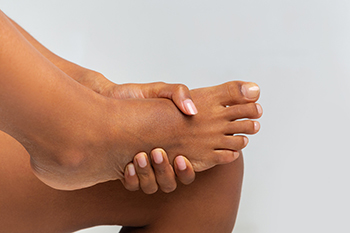
Foot drop, also known as drop foot, is a condition where lifting the front part of the foot becomes difficult, causing it to drag while walking. It results from weakness or paralysis of the muscles that lift the foot, often due to nerve damage, muscle disorders, or brain and spinal cord conditions like stroke or multiple sclerosis. Common causes include peroneal nerve injury, herniated discs, diabetes, or neurological disorders. Anyone can develop foot drop, but it is more likely in those with conditions affecting the nerves or muscles. Symptoms include dragging the toes, difficulty walking, and a steppage gait, where the knee lifts higher than usual. Diagnosis involves a physical exam, imaging like an MRI scan, and nerve conduction studies. Treatments may include braces, targeted exercises, or surgery in severe cases. If you have this uncomfortable condition, it is strongly suggested that you consult a podiatrist who can offer a personalized approach to manage foot drop effectively.
Foot Pain
Foot pain can be extremely painful and debilitating. If you have a foot pain, consult with one of our podiatrists from Lovely Foot Associates, PC. Our doctors will assess your condition and provide you with quality foot and ankle treatment.
Causes
Foot pain is a very broad condition that could be caused by one or more ailments. The most common include:
Diagnosis
To figure out the cause of foot pain, podiatrists utilize several different methods. This can range from simple visual inspections and sensation tests to X-rays and MRI scans. Prior medical history, family medical history, and any recent physical traumatic events will all be taken into consideration for a proper diagnosis.
Treatment
Treatment depends upon the cause of the foot pain. Whether it is resting, staying off the foot, or having surgery; podiatrists have a number of treatment options available for foot pain.
If you have any questions, please feel free to contact our office located in Johnstown, PA . We offer the newest diagnostic and treatment technologies for all your foot care needs.
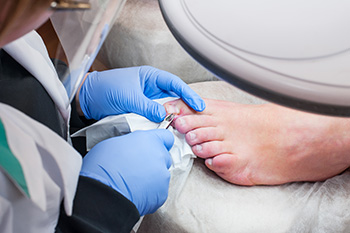
An ingrown toenail occurs when the edge of a toenail grows into the surrounding skin, causing pain, redness, and swelling. Common causes include improper nail trimming, tight footwear, or trauma. When conservative measures fail, a podiatrist may recommend nail removal techniques to resolve the issue. One type of ingrown toenail surgery involves partial nail avulsion, where the affected edge of the toenail is carefully removed while preserving the healthy nail plate. To prevent recurrence, a lateral matricectomy may be performed, which involves removing or destroying the nail-forming tissue on the side of the nail to stop regrowth of the problematic section. Electrocautery, a method that uses heat from an electrical current, is often used during this process to precisely target and destroy the nail matrix. In cases of significant infection or tissue overgrowth, the surrounding granulation tissue may also be removed to restore the toe’s natural shape. If you have a painful or infected ingrown toenail, it is suggested that you schedule an appointment with a podiatrist for treatment options.
Foot surgery is sometimes necessary to treat a foot ailment. To learn more, contact one of our podiatrists of Lovely Foot Associates, PC. Our doctors will assist you with all of your foot and ankle needs.
When Is Surgery Necessary?
Foot and ankle surgery is generally reserved for cases in which less invasive, conservative procedures have failed to alleviate the problem. Some of the cases in which surgery may be necessary include:
What Types of Surgery Are There?
The type of surgery you receive will depend on the nature of the problem you have. Some of the possible surgeries include:
Benefits of Surgery
Although surgery is usually a last resort, it can provide more complete pain relief compared to non-surgical methods and may allow you to finally resume full activity.
Surgical techniques have also become increasingly sophisticated. Techniques like endoscopic surgery allow for smaller incisions and faster recovery times.
If you have any questions please feel free to contact our office located in Johnstown, PA . We offer the newest diagnostic and treatment technologies for all your foot and ankle needs.
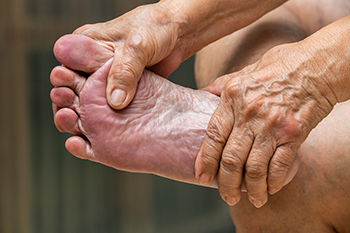
As we age, our feet go through changes like thinning skin, reduced cushioning, and decreased circulation, making them more vulnerable to pain, dryness, and injuries. Conditions like arthritis, bunions, and toenail problems are also more common in older adults. Proper foot care is essential to maintain mobility and overall health. Elderly individuals may struggle to care for their feet due to limited flexibility or vision. Family members and caregivers can help by checking for signs of issues like sores, swelling, or changes in skin or nail appearance. Regularly moisturizing, trimming toenails properly, and ensuring comfortable, supportive footwear can prevent problems. A podiatrist plays a vital role in elderly foot care by diagnosing and treating issues early. They can provide professional nail care, manage chronic conditions, and recommend orthotics to support aging feet. If you are a senior or helping to take care of one, it is suggested that you schedule regular appointments with a podiatrist for care.
Proper foot care is something many older adults forget to consider. If you have any concerns about your feet and ankles, contact one of our podiatrists from Lovely Foot Associates, PC. Our doctors can provide the care you need to keep you pain-free and on your feet.
The Elderly and Their Feet
As we age we start to notice many changes in our body, but the elder population may not notice them right away. Medical conditions may prevent the elderly to take notice of their foot health right away. Poor vision is a lead contributor to not taking action for the elderly.
Common Conditions
Susceptible Infections
Diabetes and poor circulation can cause general loss of sensitivity over the years, turning a simple cut into a serious issue.
If you have any questions please feel free to contact our office located in Johnstown, PA . We offer the newest diagnostic and treatment technologies for all your foot and ankle needs.
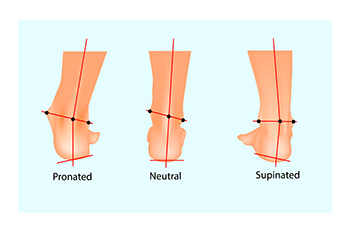
Cricket might seem like a game with minimal risk of injuries, but it can take a toll on players’ bodies, especially their feet. Bowlers and batters experience different stresses based on their roles and techniques. Pace bowlers, known for their high-speed deliveries, are more likely to have pronounced foot posture, where the foot rolls inward on impact. This results from the intense forces generated during their run-up and landing. Spin bowlers, who rely on slower, spinning deliveries, more often display supinated foot posture, where the foot rolls outward. This is due to the twisting and pivoting movements needed to spin the ball effectively. Batters, who focus on quick, agile footwork to face the ball, may develop imbalances in foot posture due to repeated pressure on the front of the foot and uneven weight distribution. If you play cricket and foot pain or injuries arise, it is suggested that you see a podiatrist for a proper diagnosis and care.
Sports related foot and ankle injuries require proper treatment before players can go back to their regular routines. For more information, contact one of our podiatrists of Lovely Foot Associates, PC. Our doctors can provide the care you need to keep you pain-free and on your feet.
Sports Related Foot and Ankle Injuries
Foot and ankle injuries are a common occurrence when it comes to athletes of any sport. While many athletes dismiss the initial aches and pains, the truth is that ignoring potential foot and ankle injuries can lead to serious problems. As athletes continue to place pressure and strain the area further, a mild injury can turn into something as serious as a rupture and may lead to a permanent disability. There are many factors that contribute to sports related foot and ankle injuries, which include failure to warm up properly, not providing support or wearing bad footwear. Common injuries and conditions athletes face, including:
Sports related injuries are commonly treated using the RICE method. This includes rest, applying ice to the injured area, compression and elevating the ankle. More serious sprains and injuries may require surgery, which could include arthroscopic and reconstructive surgery. Rehabilitation and therapy may also be required in order to get any recovering athlete to become fully functional again. Any unusual aches and pains an athlete sustains must be evaluated by a licensed, reputable medical professional.
If you have any questions please feel free to contact our office located in Johnstown, PA . We offer the newest diagnostic and treatment technologies for all your foot and ankle needs.
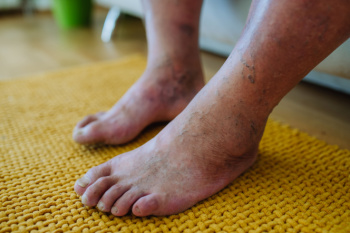
Foot problems caused by diabetes can significantly affect a patient’s health and quality of life. Two common conditions that contribute to diabetic foot complications are loss of protective sensation, or LOPS, and peripheral artery disease, or PAD. Loss of protective sensation occurs when high blood sugar levels damage the nerves in the feet, leading to reduced sensation. This can prevent a diabetic patient from feeling injuries like sores, blisters, or temperature changes, which in turn increases the risk of developing wounds that may become ulcerated or infected. Peripheral artery disease restricts blood flow to the feet resulting from a buildup of plaque. This slows the healing of sores and can lead to foot ulcers or, in severe cases, amputations. A podiatrist can monitor and address these problems by assessing nerve function, checking circulation, and providing guidance on protective footwear and foot care routines. If you have foot problems caused by diabetes, it is suggested that you schedule regular visits to a podiatrist who can help you to manage them.
Diabetic foot care is important in preventing foot ailments such as ulcers. If you are suffering from diabetes or have any other concerns about your feet, contact one of our podiatrists from Lovely Foot Associates, PC. Our doctors can provide the care you need to keep you pain-free and on your feet.
Diabetic Foot Care
Diabetes affects millions of people every year. The condition can damage blood vessels in many parts of the body, especially the feet. Because of this, taking care of your feet is essential if you have diabetes, and having a podiatrist help monitor your foot health is highly recommended.
The Importance of Caring for Your Feet
Patients with diabetes should have their doctor monitor their blood levels, as blood sugar levels play such a huge role in diabetic care. Monitoring these levels on a regular basis is highly advised.
It is always best to inform your healthcare professional of any concerns you may have regarding your feet, especially for diabetic patients. Early treatment and routine foot examinations are keys to maintaining proper health, especially because severe complications can arise if proper treatment is not applied.
If you have any questions please feel free to contact our office located in Johnstown, PA . We offer the newest diagnostic and treatment technologies for all your foot and ankle needs.
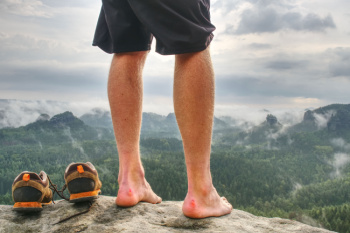
Heel blisters are fluid-filled bubbles that form on the skin due to friction, pressure, or heat. They are common among people who spend long hours walking, running, or wearing poorly fitting shoes. The main cause of heel blisters is friction between the heel and shoe, which causes the skin to rub and separate. This leads to a buildup of fluid underneath the skin. Factors such as moisture, wearing tight shoes, or lack of proper cushioning can increase the likelihood of blisters. To prevent them, it is important to wear well-fitted shoes that provide proper support. Additionally, wearing moisture-wicking socks can help reduce friction. Heel blisters can become infected, and can cause difficulty in wearing shoes. If you have developed this or any type of foot blister, it is suggested that you confer with a podiatrist who can treat infected blisters, and offer additional prevention tips.
Blisters may appear as a single bubble or in a cluster. They can cause a lot of pain and may be filled with pus, blood, or watery serum. If your feet are hurting, contact one of our podiatrists of Lovely Foot Associates, PC. Our doctors can provide the care you need to keep you pain-free and on your feet.
Foot Blisters
Foot blisters are often the result of friction. This happens due to the constant rubbing from shoes, which can lead to pain.
What Are Foot Blisters?
A foot blister is a small fluid-filled pocket that forms on the upper-most layer of the skin. Blisters are filled with clear fluid and can lead to blood drainage or pus if the area becomes infected.
Symptoms
(Blister symptoms may vary depending on what is causing them)
Prevention & Treatment
In order to prevent blisters, you should be sure to wear comfortable shoes with socks that cushion your feet and absorb sweat. Breaking a blister open may increase your chances of developing an infection. However, if your blister breaks, you should wash the area with soap and water immediately and then apply a bandage to the affected area. If your blisters cause severe pain it is important that you call your podiatrist right away.
If you have any questions, please feel free to contact our office located in Johnstown, PA . We offer the newest diagnostic and treatment technologies for all your foot care needs.

Choosing the correct shoe fit is both an art and a science. It begins with matching the shoe shape to the natural form of your foot, ensuring the shoe follows your foot’s contour. Size is also key, and it is best determined by the length of the arch rather than simply by toe position. A well-fitting shoe should allow the first metatarsal joint, the base of the big toe, to sit in the shoe’s widest area. For maximum comfort, look for lightweight shoes with soft midsoles and gently curved rocker soles. These features tend to feel better for everyday wear. Flexibility in the sole, internal shoe temperature, and insoles can affect comfort, although these factors may vary based on individual needs and activities. Ultimately, a good fit supports foot health and enhances comfort, helping you stay active and pain-free. If you want assistance in selecting the right shoe fit for you, it is suggested that you reach out to a podiatrist for guidance.
Getting the right shoe size is an important part of proper foot health. Seek the assistance of one of our podiatrists from Lovely Foot Associates, PC. Our doctors will provide the care you need to keep you pain-free and on your feet.
Getting the Right Shoe Size
There are many people who wear shoes that are the incorrect size, negatively affecting their feet and posture. Selecting the right shoes is not a difficult process, so long as you keep several things in mind when it comes to choosing the right pair.
As our feet hold our body weight and keep us moving, it is important to treat them right. Picking the right pair of shoes can provide your feet comfort and mobility without pain.
If you have any questions, please feel free to contact our office located in Johnstown, PA . We offer the newest diagnostic and treatment technologies for all your foot care needs.